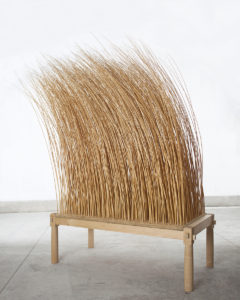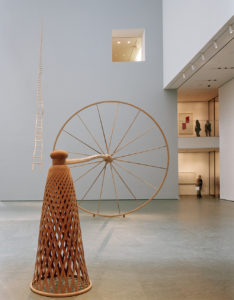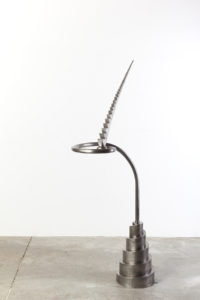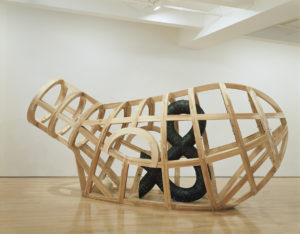IN 1997, THE ST. JAMES GUIDE TO BLACK ARTISTS called sculptor Martin Puryear a quiet revolutionary engrossed in the business of eroding art-world oppositions. “I would describe my usual working process as a kind of distillation—trying to make coherence out of things that can seem contradictory,” he says. “But coherence is not the same as resolution. The most interesting art for me retains a flickering quality, where opposed ideas can be held in a tense coexistence.” Contradiction, dichotomy, and paradox provide a perfect working space for Puryear: high art versus craft, western versus global culture, personal versus universal forms. In the space between poles, his imagination cycles freely. The pursuit of the unresolved energizes and satisfies him—and protects him, a mere mortal, from the heavy mantle of art-media titles like “the greatest black American artist” and “his generation’s most preeminent sculptor.”
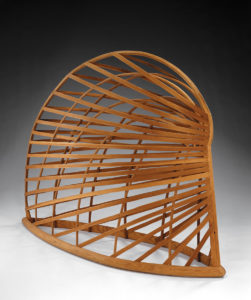
Martin Puryear. Bower, 1980. Sitka spruce and pine. 5¼ x 8 x 2¼ feet. All images © Martin Puryear, courtesy Matthew Marks Gallery.
Art history surveys reduce Martin Puryear’s prodigious body of work to a couple of iconic pieces like Bower (1980) and Plenty’s Boast (1994). The thin strips of Sitka spruce and minute copper nails that bend Bower into its lyrical shape exemplify Puryear’s fifty-year love affair with meticulous hand-construction techniques and ancient crafts. Bower’s frame suggests the armature of a hut or the skeleton of a boat, but the piece offers no shelter or seaworthiness—it just suggests our desire for them. Plenty’s Boast is one of many examples of Puryear’s genius for pulling a sense of elasticity out of rigid materials. A plump, fluid cornucopia in ringed segments of red cedar and pine, its flaccid, slightly deflated presence ends in a sharp rat-tail point. The boast on offer is breathtakingly elegant, but empty.
Bower and Plenty’s Boast both contradict the reputation for minimalism that Puryear earned after his graduate studies at Yale, during the late sixties. “I never did minimalist art,” he said in 1984. Though studio classes under Richard Serra and Robert Morris forced him to flirt with it, he could never absorb its distancing methodology or cold intellectualism. “I got real close. I looked at it, I tasted it, and I spat it out. I said, this is not for me. I’m a worker. I’m not somebody who’s happy to let my work be made for me and I’ll pass on it, yes or no, after it’s done. I could never do that.”
Never say never, of course. A 2003 documentary captures the seventy-five-year-old fretting slightly as he oversees the production of monumental stone and metal-sheathed menhirs for corporate plazas. His five-story-high mesh folly Big Bling (2016) required the retooling of machinery at the firm that laminated its steeply curved plywood trusses. The monolithic “head bud” Guardian Stone (2003), made for the headquarters of TV Asahi in Tokyo, required a phalanx of translators. With their help, Puryear selected black granite boulders from a quarry in China, oversaw the Japanese master masons who scaled his maquette up nineteen times, and midwifed the installation of eighteen tightly engineered segments, then directed the hand-chiseled patterns that soften the work’s surface.
Before any of this takes place, Puryear’s imagination moves like a gentle, introspective shark, circulating tirelessly through an ocean of ideas, always moving lest it suffocate. Along the way, he has garnered a cumulus of honors: an NEA fellowship, a Guggenheim fellowship in Japan, residencies at the American Academy in Rome and at Yaddo, a MacArthur “genius” grant, and election to the American Academy of Arts and Letters. By all accounts he values productivity above anything else, and despite his ambition he’s known as a dignified, humble, restrained man. Some critics go so far as to describe him as egoless. He avoids publicity and carefully guards the privacy of his life with his wife Jeanne and daughter Sascha. He bears the same quiet mien and perpetual scowl of concentration today as in photos from his twenties.
Many critics have overtly admired him, sometimes to the point of hyperbole. In 1990 when Puryear left his adopted home of Chicago, the Tribune critic lamented the loss of “the first Chicago artist who had conquered the rest of the world since the photographer Harry Callahan did it in the 1960s.” A couple of years later, the Washington Post claimed him for DC: “Not since the 1960s…has a modernist from Washington earned such well-deserved acclaim.”
Connections to Washington, DC, run through Puryear’s life from beginning to end. He describes an epiphany at age six that “just blew something open in me,” when he observed a black artist painting a portrait on a Washington sidewalk. His interest prompted an uncle to take his drawings to an after-school arts program, where a scholarship supported him over the next four years, often as the sole African American student. In 1977, the Corcoran Gallery, across from the White House, mounted Puryear’s first major solo exhibit, and in 1992, DC’s Hirshhorn Museum hosted his first retrospective. In 2012, Barack Obama placed a National Medal of Arts on Puryear’s shoulders in the East Room of the White House.
Puryear was the oldest of seven, born in 1941 to savvy, resourceful parents of relatively modest means in DC, two decades before LBJ signed the Civil Rights Act into law. The family partook liberally of the capital’s many cultural events and museums—a perk that offset its eroding neighborhoods, racial tensions, and fraying infrastructure. Puryear’s grandmother repaired clocks, and most of his siblings eventually pursued professions that required handwork: wood joinery, cuisine, weaving, printmaking, and music. One brother now curates the Smithsonian Institution’s Center for Folklife and Cultural Heritage, while another is directing the creation of a fourteen-mile recreational park along the Brooklyn waterfront. In his youth, Martin built guitars, boats, and furniture as family projects, and still gives the canoe he made with his brother and portaged through Lapland in the sixties pride of place in his studio. Years before Puryear set foot overseas, his insatiable curiosity led him on many visits to the Smithsonian Museum of Natural History, the National Gallery, and the Phillips Collection, with its wealth of Brancusi sculptures. But he traveled farthest of all with his mind, through books. He worked for almost a decade at a DC library, starting at the age of seventeen, and still describes book buying as his “safe addiction.”
The Puryear DNA came out of Africa, survived slavery, and was carried north by Martin’s paternal grandfather, a Baptist minister who moved to Nova Scotia in the late 1800s to serve the largest concentration of freed slaves in North America, including several hundred Jamaican exiles misnamed “maroons,” from the Spanish cimarrones (wild, untamed) and perhaps marrones (brown). The ten-foot bulge of Maroon (1978) begs to be connected with its historical source. The suggestion of a ship’s hatch, cut in a canting, boat-like deck, caps a lurching vessel of tar-coated mesh. Its presence is both dark and menacing, and also fluid and permeable—but in either case, it won’t hold water.
Despite his Baptist lineage, Puryear attended Catholic high school and transferred from a local teaching college to Catholic University of America in 1960 to major in biology. He switched to painting as a junior, convinced by the examples of minimalist Kenneth Noland and other studio faculty that artists could actually make a living. He was determined to master realism in the vein of Andrew Wyeth, but credits Nell Sonnemann with helping him release his “death grip” on verisimilitude. She remembered Puryear as “a quiet young man who withheld himself from direct exchange…then, bam…he just busted out of the womb all of a sudden. It was an exploding transfiguration.” A textile artist and painter, Sonnemann traveled the world recording fabrics and techniques, and she piqued Puryear’s curiosity about cross-cultural artisanship at a time when the dominance of abstract expression marginalized the technical discipline and idiosyncrasies of craft.
In 1964, Puryear crossed the Atlantic on his first overseas trip, to the recently independent Sierra Leone, for the newly formed Peace Corps. He found himself treated as a foreigner by the Mende people, who initially dismissed his blackness as somehow less than authentic. “The name for me was the same as for Europeans,” he explained to the New York Times. “It was very clear to me that I wasn’t one of them.” He taught secondary school, languages, and art for two years in the town of Segbwema, eventually winning the villagers over with his gentle but persistent curiosity. In a place that lacked electricity and power tools, Puryear developed deep respect for what he called the “hard back work” demanded by West African carpentry, carving, and basket weaving.
ArtScene commentator Kate Liebman recently described a pivot in Puryear’s sensibilities from “monumental” to “archetypal” following his travels to Sierra Leone, Senegal, Nigeria, and Morocco. Never merely imitating or modernizing the artifacts he saw, Puryear began assimilating their essence, like a focusing lens. Intentionally leaving his camera behind, he sketched the handmade objects that still flavor his work, such as the framing of simple huts outlined in the drypoint etching Gbow’s Gard (1966). The strategy of exposing deep structure through a frame reemerges in works like Bower, Vessel (2002), and Big Bling (2016). Basket weaves and armatures meticulously pieced together from spruce shavings, cedar strips, willow whips, and rattan provide the frames for Desire (1981), Old Mole (1985), The Charm of Subsistence (1989), and Brunhilde (2000). The traditional headgear in the drypoint portrait Gbago (1966) evokes a floppy stocking cap, the bobbed hat of a Japanese Shinto priest, and the red Phrygian caps of Haitian and French revolutionaries, seen on the head of Delacroix’s Lady Liberty. Head buds and other organic-looking blobs formed with tarred wire mesh like Maroon and Horsefly (2000) converse with two-dimensional aquatints and drawings like Untitled I (2002), which defines a Maroon-like shape with white X-ray lines.
Puryear’s sculptural forms tango with his drawings, aquatints, flat bite and spit bite etchings, and Chine-collé transferals. Thick, vigorous crosshatches in pencil, black gouache, crushed charcoal, or Conté crayon are echoed in the tarred mesh surfaces of sculptures. Snippets of text float in the margins of Manila cardstock or striped French butcher paper: were slaves or transcendant [sic] on an African hut, for instance. In 1999, Puryear re-engaged with the graphic arts of his twenties when he accepted an invitation from Arion Press to provide woodcuts for Cane, a classic work of the Harlem Renaissance published in 1923. Though he was initially hesitant about working with printers, his experience with Cane inspired Puryear to throw himself back into printmaking late in his career with such experts as Andrew Hoyem at Arion in San Francisco and Renee Bott at the Paulson Fontaine Press in Berkeley.
He accepted the Cane project out of an affinity for its DC-born author, Jean Toomer, who experienced life as an outsider among the literati and strove to define blackness. While Puryear does not conspicuously emphasize his roots as an African American, they emerge in certain tropes: aspiring to go higher, carrying loads, being confined, moving in futile or productive ways, being spied upon, and developing inscrutability as a form of self-protection. In DC’s black community, he experienced the traumatic violence that met the Civil Rights movement, Martin Luther King’s calls for nonviolent resistance, and Malcolm X’s attempts to start the Organization of Afro-American Unity. In 1963, at twenty-two, Puryear witnessed King’s “I Have a Dream” speech in the crowd at the Lincoln Memorial and absorbed the chaotic aftermath of Kennedy’s assassination. Liebman surmises that it was Puryear’s experiences in Africa that “allowed him to recognize how deeply, yet how falsely, the binary of black and white exists in the American conception of race.” As early as 1967, Puryear’s aquatint etching Quadroon made an overt statement about racial segregation. It displays four smudged segments that darken from pink blush to tan to black, and its title underscores historic racial categories—in slave societies, “quadroon” meant one-quarter African, three-quarters white.
Puryear’s motifs of surveillance, containment, and escape contain quiet allusions to American slavery, for those who are willing to look. For example, the carefully arranged willow switches of Night Watch (2011) might convey the amber waves of grain of our national mythology or arms upraised in “hallelujah!”—but just as plausibly, each six-foot switch might symbolize the stroke of a whip. Brooklyn Rail critic Phong Bui sees in the studied drilling of hundreds of holes at tight intervals a specific allusion to Africans packed into ships, and in the curved blades of willow, the fields that concealed escaping slaves. Puryear’s title is borrowed from Rembrandt’s famously misnamed painting of a group of civic guardsmen—actually a daytime scene darkened by dirt and oxidizing varnish. He may also be alluding to Rembrandt’s subtle visual commentary on the “cockiness” of its vain subject, Captain Cocq. It might not be overreaching to suggest that Puryear’s title telegraphs the blatant misnaming of a historical event (slavery), or the hubris of masters who felt they owned the bodies of other humans and could therefore whip them without moral consequence. In this light, Puryear’s meticulous drilling process might be considered a meditation. He removes substance (making holes) to build meaning (the history of black Americans).
It’s not unlikely that some Thomist theology may have seeped into Puryear’s studies at Archbishop Carroll High School and Catholic University, but most critics have said little about his religious influences. Bryan J. Wolf, a Stanford art historian emeritus, is virtually unique in his effort to examine Puryear with an eye to religion. In an essay for Yale’s Center for the Study of Material and Visual Cultures of Religion, he explores the connection by focusing on Desire (1981). Exhibited most effectively in the open atrium spaces at the 2007 retrospective at MoMA, Fort Worth, and San Francisco, Desire connects a huge spindly wheel to an elegant eight-foot pylon woven from spruce shavings by means of a thirty-two-foot trunk of spliced raw wood. The towering, double-spoked wheel bulges out from its axle, demanding space and leeway. Left unhindered, the wheel would roll in endless circles around its basket anchor.
The ancient craft of basketry, weighted with implied tradition, anchors the massive, frozen wheel of Desire, but the anchor is paradoxically flimsy—a see-through weave, a fragile, temporary form pierced by the very space it inhabits. Wolf draws a connection to Martin Luther King’s doctoral dissertation on theologian Paul Tillich. King accepted Tillich’s proposition that sin is separation, an observation pertinent to any discussion of racism. In his grasp of contradiction, Puryear embraces Tillich’s dialectic notion of tension between poles. Wolf emphasizes that Desire illustrates two entities kept at arm’s length from each other. “What counts…is the gap, the longing, which seems unresolvable: the twoness that can never be one.” There is the distance between God and us, I and Thou; there is also Puryear’s sense of distance, as an outsider, from the center of American society. Desire portrays a relationship of endless circling and non-functionality, which Wolf interprets as an allusion to the meandering, irresolute manner in which we discuss race, “a topic both visible and hidden, a subject with a public face and a veiled interior. African American life has been filled with voices that hide—as a matter of survival—what they cannot afford to reveal.”
In Desire, Wolf sees Puryear’s trademark contradictions in the juxtaposition of the everyday and the extraordinary. Desire is built from plain, unfinished poplar, cedar, and pine, but its extraordinary proportions and patent uselessness give it an alienating sense of strangeness. “And this is where religion enters the picture,” Wolf suggests. “That dialectic suggests a yearning from the peripheries for a center always experienced at a distance.”
Puryear never suffered ostracism in the art world, however. In 1999, he accepted an invitation to join a prestigious roster of artists tasked with the ongoing project of reconfiguring Paris’s Chapelle Saint-Louis de la Salpêtrière; the list eventually included Jenny Holzer, Anish Kapoor, Nan Goldin, Mario Merz, and Bill Viola. The hospital complex to which the chapel belongs was sponsored by Louis XIV during the 1790s and later became a lunatic asylum and prison for prostitutes and other cast-offs. It eventually grew into the largest, most prestigious teaching hospital in Europe, famous as a center for research on mental illness. Freud visited in 1885. Foucault and Princess Diana drew their last breaths there.
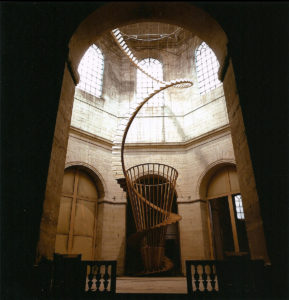
Martin Puryear. This Mortal Coil, 1998–99. Red cedar, stainless steel cable, aluminum, muslin. 85 x 39 x 52 feet.
To pull off the illusion of weightlessness that animates This Mortal Coil, Puryear laboriously constructed an eighty-foot corkscrew of dozens of muslin-covered steps. They rise into the space of the vaulting dome as if floating on air, inspired directly by the undulating, dissolving walls and spiraling domes of the Italian Baroque. The steps diminish in scale as they climb towards an invisible infinity, but remain grounded by a conical base of wooden spokes. The staircase hangs from a series of precisely spaced steel cables, suggesting a sense of precarious motion and literal suspense. In the process of being “shuffled off,” as Shakespeare put it, this mortal coil is frozen in a moment—about to either fall to earth like a discarded bandage or be drawn up into the swirling vortex of heaven like El Greco’s Count Orgaz.
Tenuous balance and aspiration also energize Heaven Three Ways/Exquisite Corpse (2011). Phong Bui sees the influence of Tatlin’s Monument to the Third International in its base, Brancusi’s Le Coq in the curving serrated blade at the top, and Puryear’s nod to Surrealism in the title. André Bretón, Marcel Duchamp, Yves Tanguy, and other surrealists played the parlor game cadavre exquis in the twenties, collectively assembling words or images into provocatively nonsensical writings or drawings. To me, however, the three-part composition irresistibly suggests an economical summation of Dante’s Divine Comedy, the scourge or crowning achievement of Catholic literature (depending on the century). Its stepped, conical base could be the negative space between the Devil’s legs, as illustrated in historical schematics for the Inferno. In the poem, Dante and his guide Virgil make their way upward to their escape, where they join the plodding circles of those who labor to escape Purgatorio through duty. Dante vaults alone up into Paradiso, or the third way to heaven, toward the unassailable holiness of Beatrice and other luminaries, who float in a realm of infinite space and light—a destination that artists have found impossible to illustrate compellingly, given that its main characteristics are ineffable.
Is Puryear offering us another paradox, juxtaposing absolute truth claims with the blurry experiences life provides? Is he, in fact, revealing his thoughts about the nature of the upward journey, either challenging or confirming the belief in infinite uplift? These stairs—like those in Mortal Coil—don’t seem to lead to a secure destination unless one has faith. Or is he simply empathizing with the arduousness of ascent? Whatever his vision, the scale and angle of these diminishing steps reappears in Puryear’s sketches for a dance and drama project in collaboration with Wynton Marsalis and playwright Garth Fagan, Griot New York. The griot is a West African storyteller, responsible for keeping the tribe’s culture alive. Marsalis’s score, Citi Movement, injects the sounds of Caribbean and African music into the swirling cultural vortex of the gray northern metropolis. Puryear may have been calling dancers down the up staircase, asking them to bring their divine source of beauty and sublimity to street level—the ultimate enterprise of art.
Switching hemispheres from Africa to Sweden in 1966 stretched Puryear’s newfound sensibility for woodworking, as he began to explore the ultramodern idiom of Scandinavian design. He started learning how to master form through a brief but close association with Siberian-born cabinetmaker James Krenov. Krenov absorbed the shapes of traditional Arctic handwork and the curves of watercraft during his upbringing in Alaska and Seattle, and championed the dignity of high craft at a time when the juggernaut of modernist theory was undercutting the value of technical discipline. Krenov also collaborated with Carl Malmsten, the father of Scandinavian modern furniture. They all met during Puryear’s studies at Stockholm’s Royal Academy of the Arts in 1966, when Krenov granted the young Puryear an unusual opportunity to apprentice in his studio. Krenov maintained that straight lines induced sleep rather than the harmony promised by modernists, and exhorted his students to “leave fingerprints.” Perhaps the smudges and thumb marks in Puryear’s graphic works pay homage to him.
In 1969, as the student world roiled with activism, Puryear left Stockholm for a Yale MFA at the sedate age of twenty-eight. Much is made of the fact that he entered the program just as its most famous minimalist graduates were returning there as instructors. Less is made of the seminar he took with Robert Farris Thompson, a globally respected authority in African studies who traced the impact of the African diaspora in New World culture, documented in his 1983 classic Flash of the Spirit: African and Afro-American Art and Philosophy. Thompson ventures far beyond blues and jazz, exploring the drumming and dance rituals of Brazil’s capoeira, Jamaica’s kumina, Havana’s mambo, and Haiti’s vodou drum ceremonies, eventually tracing the African thread to its recent syntheses in the New World griots who created slam poetry, hip-hop, and rap.
I experienced the “Thompson effect” myself as a student at Yale in 1996, sitting at the same dining-room table where Puryear sat a few decades earlier, crowded by the same collapsing piles of dusty, glass-mounted slides, Gabonese masks, nail-spiked fetishes in full arousal, hoary spears, fraying shields, and fading Polaroids of rituals that Thompson endured as an initiate of half a dozen secret societies. Wholly committed to the vital expression he identified as “Black Atlantic” art, Thompson insisted that no notion of American identity would be accurate until Americans came to terms with the contributions of black culture. Perhaps this deepened Puryear’s sense of his responsibilities as a gifted shaman-storyteller-artist—the griot who maintains the richness of his culture in the face of a world that tries to appropriate it.
Puryear accepted a teaching post at Fisk University in 1971 and moved to Nashville, which probably felt like returning to the 1950s. A historically black college founded in 1867, Fisk’s graduates include the likes of W.E.B. Dubois and Judith Jamison, its faculty, Booker T. Washington and Thurgood Marshall. Since 1949, Fisk has been the silent custodian of a stellar modern art collection donated by Georgia O’Keeffe, who evidently wanted to spread works from the modernist canon beyond the usual art world confines. Fisk did little to publicize the collection for many years, and works by Cezanne, Renoir, Toulouse-Lautrec, Sheeler, Demuth, Picasso, Hartley, and Dove, as well as Stieglitz and O’Keeffe classics, remained mounted on Masonite partitions in the basement of a Victorian pile that once functioned as a gym.
In the late 1930s, thanks to a Rockefeller grant program, Fisk received a traveling MoMA exhibit called “African Negro Art,” accompanied by a portfolio featuring more than five hundred African artifacts, photographed by Walker Evans. The exhibit included the famous Fang mask from Gabon or Cameroon that became an icon of “primitivism” for modernists. Years later, the same mask made an unforgettable impression on Puryear during his first solo visit to New York in 1960, and its form has reappeared in several of his works. Its profile is echoed in his forty-foot public sculpture Bearing Witness (1997) at the Ronald Reagan International Trade Plaza in DC; in Confessional (2000), it is stripped down to its essence in tar, mesh, and wood; and most prominently, it appears in reverse relief in C.F.A.O. (2007).
C.F.O.A. refers to the Compagnie Française, a nineteenth-century West African trading company that made African culture into a commodity. Puryear pinions the ritual mask to an unyielding thicket of square dowels, separating it from the world around it—a product ready for transport, a sacred object about to be yanked away from its origins. The whole arrangement balances precariously on an old wooden wheelbarrow Puryear found in 1992 during his residency at Alexander Calder’s studio in the Loire Valley. Appropriation is unusual for Puryear, but he admits that it can helpfully sabotage his need for control and allow for “some chance and spontaneity.”
Tropes of movement and portability recur in the antiquated cartwheels of works like Ad Astra (2007), The Rest (2010), or The Load (2012) and in the primitive, trunk-like rollers of Hominid (2011). All suggest the exhausting prospect of dragging heavy burdens long distances with poor equipment—which some critics have pointed to as a direct allusion to the experience of enslaved Americans.
Puryear resigned in quick order from positions at Fisk, the University of Maryland, and the University of Illinois, as he found that teaching hampered his productivity. After Fisk, he headed for a warehouse loft in Brooklyn on the Jamaica line—far from the trendy, expensive art corridors of SoHo and Tribeca. He describes his neighborhood in pre-Giuliani New York as the kind of place where your truck battery might disappear in half an hour if you parked on the street, with the rest of the truck following in short order.
In a 2007 interview, he spoke with his Hudson Valley neighbor, the poet and art writer David Levi Strauss, about the struggle to get noticed: “It just wasn’t happening, because I didn’t have the ability to do what we call today ‘networking’…. I had a lot of friends, but I didn’t seem able to translate that into a contact that would get me someplace in terms of serious gallery exposure.” In 1977, a fire in his building consumed most of his early work and personal possessions, leaving only a few surviving sculptures. Some Tales (1975–78), for example, fills a thirty-three-foot space with whispering, spindly wood shapes that evoke hairpins, needles, shards, hooks, and saw teeth. Some Lines for Jim Beckwourth (1978), finished after the fire, features eight twenty-foot parallel skeins of twisted rawhide and varicolored cattle hair. The title memorializes a nineteenth-century trader and Indian Territory guide, born of a British peer and a slave, who became a Crow chief and published a somewhat self-aggrandizing biography shortly before his unsolved murder.
In hindsight, Puryear came to see the blank slate left by the fire as giving him “an incredible lightness and freedom…the genesis of the whole growth of my work from that point on. And I did feel in some strange way that suddenly I had no past, but since my past was obliterated, I felt liberated to move forward into a new future.” Understandably, post-fire works like Bower and a yurt assemblage called Where the Heart Is [Sleeping Mews] (1981) allude to light, portable homes and temporary sanctuaries.
As a writer, Levi Strauss appreciates Puryear’s “open-ended and poetic” titles. Critics often cannot resist anchoring them to specific metaphors or moments in history, and many have noted Puryear’s predilection for puns. For example, Where the Heart Is [Sleeping Mews] is a homey space within an open yurt frame, protected by two falcon effigies. A mews is a hawk house, but the title also plays on Brancusi’s Sleeping Muse. Despite the fact that Puryear’s titles offer tantalizing hints, he insists that he is reluctant to provide “a key to unlock a work and interpret it.” Titles may suggest content, and the content may resonate deeply with the artist or viewer, but the sculptures never wholly illustrate an idea. “I came from a generation where the work was itself the information,” he explains, “and so, there remains this belief that the work itself can have an identity that can hopefully speak. The work doesn’t have to be a transparent vehicle for you to say things about life today, or what you see people doing to each other, or things like that.”
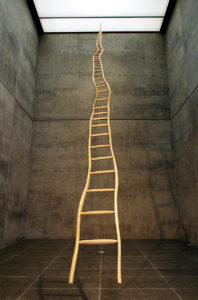
Martin Puryear. Ladder for Booker T. Washington, 1996. Ash and maple. 36 x 2 x ¼ feet. © Martin Puryear, courtesy Matthew Marks Gallery.
Puryear relaxed his own strictures for titling with Ladder for Booker T. Washington (1996) [see front cover], which began with the technical challenge of splitting a length of crooked maple in half. Viewed from below, the ascending ladder appears much longer than its actual thirty-six feet. A foot wide at the bottom, it tapers to an inch or so at the top, exaggerating the illusion of great length. In retrospect, Puryear believes the title confines the composition “in a fairly specific and rather concrete way, which many people will probably never get out of—they’ll just see it as a metaphor for a certain social idea.” Curators could not resist connecting the form to Washington’s biography, overwriting Puryear’s intentions for the piece as an example of woodworking expertise and aesthetic sublimity. Wall texts became history lessons for schoolchildren. Some immediately saw Jacob’s ladder connecting heaven and earth; others recalled Washington’s campaign for “racial uplift” through vocational training; still others saw the dizzying ascent out of slavery toward an impossibly distant and invisible salvation. “The title came after the work was finished, first of all,” Puryear patiently insisted in a 2003 PBS interview. “I didn’t set out to make a work about Booker T. Washington.”
The work was really about using the sapling, using the tree. And making a work that had a kind of artificial perspective, a forced perspective—an exaggerated perspective that made it appear to recede into space faster than, in fact, it does…. It’s an idea [I’d] been wanting to do for a long time. Once it was finished I realized it was probably something that should exist in a kind of idealized space that does not invite any kind of accessibility, approachability, or usability, whether real or imagined. It’s just an image or a presence in a space…and the title, despite its specificity, was a complete afterthought. But it seemed so apt, given the contorted, precarious ascent presented by the ladder and its distorted perspective, that I couldn’t resist it…. I feel that our knowledge of each other’s history in this country is so spotty that if I can put something out there, and people get curious, they might learn a little bit about the whole history, and that’s not a bad thing.
Puryear also tantalizes with partial titles, such as Everything That Rises (1996) for the University of Washington physics campus. The title begs to be completed as “Everything That Rises Must Converge,” Flannery O’Connor’s story about racial prejudice. O’Connor borrowed the title from Catholic theologian Teilhard de Chardin, who referred to union with God as a “convergence” in Cosmogenesis (1922). In the courtyard of a physics complex on a Seattle campus, the peanut-shaped bronze form appears to balance mysteriously on its rounded tip, as if transcending the laws of physics, and gravity itself.
Puryear often repeats the same shape in different materials and sizes. The form of the fifteen-foot Vessel, delineated in chunky pine framing, reappears exactly in the much smaller white bronze bust Face Down (2008). Both seem inspired by the back of a Ngil mask, worn among the Fang people of Gabon by a secret society of judges—the same form poached by Picasso and other modernists. As one walks around Face Down, holes in the skull, which initially seem like the stubble of a buzz cut, flutter with light. Authentic Ngil masks had raffia, rawhide, or animal hair plugged into these holes. Critic John Yau links the sheeny effect of Puryear’s white bronze with the traditional application of white kaolin to Ngil masks to evoke the otherworldly, ethereal presence of the dead. In both works, the face is shoved into the floor, completely hidden. Yau proposes that this memorializes and figuratively entombs the features that European modernists appropriated. Yau also interprets the rounded neck as a handle—something suggestive of ceremonial use—and notes how the form echoes Brancusi’s Sleeping Muse, like a tribute. For the much larger Vessel, which rests on the floor, the cylindrical neck functions more as a portal, and the crown of the head, almost six feet high, seems more like a target, inviting penetration. As one walks around the massive pine trusses of the open structure, the tarred ampersand suspended inside changes meanings: seen from the side, it suggests a head filled with connections and facts and observations, and may be autobiographical. Seen end-on from the crown or neck, the ampersand flattens into a black line that bisects the space, like a slash on a keyboard—like the space between contradictions.
While Vessel opens itself freely, the cedar and mahogany Self (1978) appears to be a dense, closed mass planted forcibly into the floor, like a massive shard of polished basalt tossed from an eruption. “It’s meant to be a visual notion of the self, rather than any particular self,” Puryear explains, “the self as a secret entity, as a secret hidden place.” Neal Benezra, director of San Francisco’s MoMA, describes Self as quirky and impersonal.
Like so many of Puryear’s works, it seems pure and simple, but it is in fact a bizarre hybrid, a bundle of surprises and oppositions. Its eccentricity has a great deal to do with the way it was made. Monolithic sculptures have traditionally been heavy, carved from blocks of stone. Self is hollow and light. It is a wooden shell, constructed by crisscrossing layers of red cedar and mahogany in a shipbuilding technique.
Self comes from a place of process rather than ego. It models the interiority, privacy, temporality, and sense of the sacred that Puryear values above all else, and also presents a knowing irony as a publicly exhibited work expressing the presence of a very private individual.
Artist, critic, and Yale arts dean Robert Storr remarked that Puryear avoids personal narratives because of a “desire for anonymity” rooted in the noble “private identity” of traditional craftsmen. Storr sees Puryear’s works as distinguished for their cultural rooting in craft and their close observation of history and nature. “What is deemphasized…is the ‘I’ or artistic ego,” Storr asserts. Rather than mining his own ego, Puryear interrogates the contradictions in human history, the created world, and his chosen materials in his most compelling compositions. As he says in his own words:
I’m making a case for my own vision. It’s like breathing. It’s not always the same. And it can change…. My work…feels like it’s got a lot more potential for evolution and change and open-endedness. Which I think feels more resonant with what it is to live a life.




